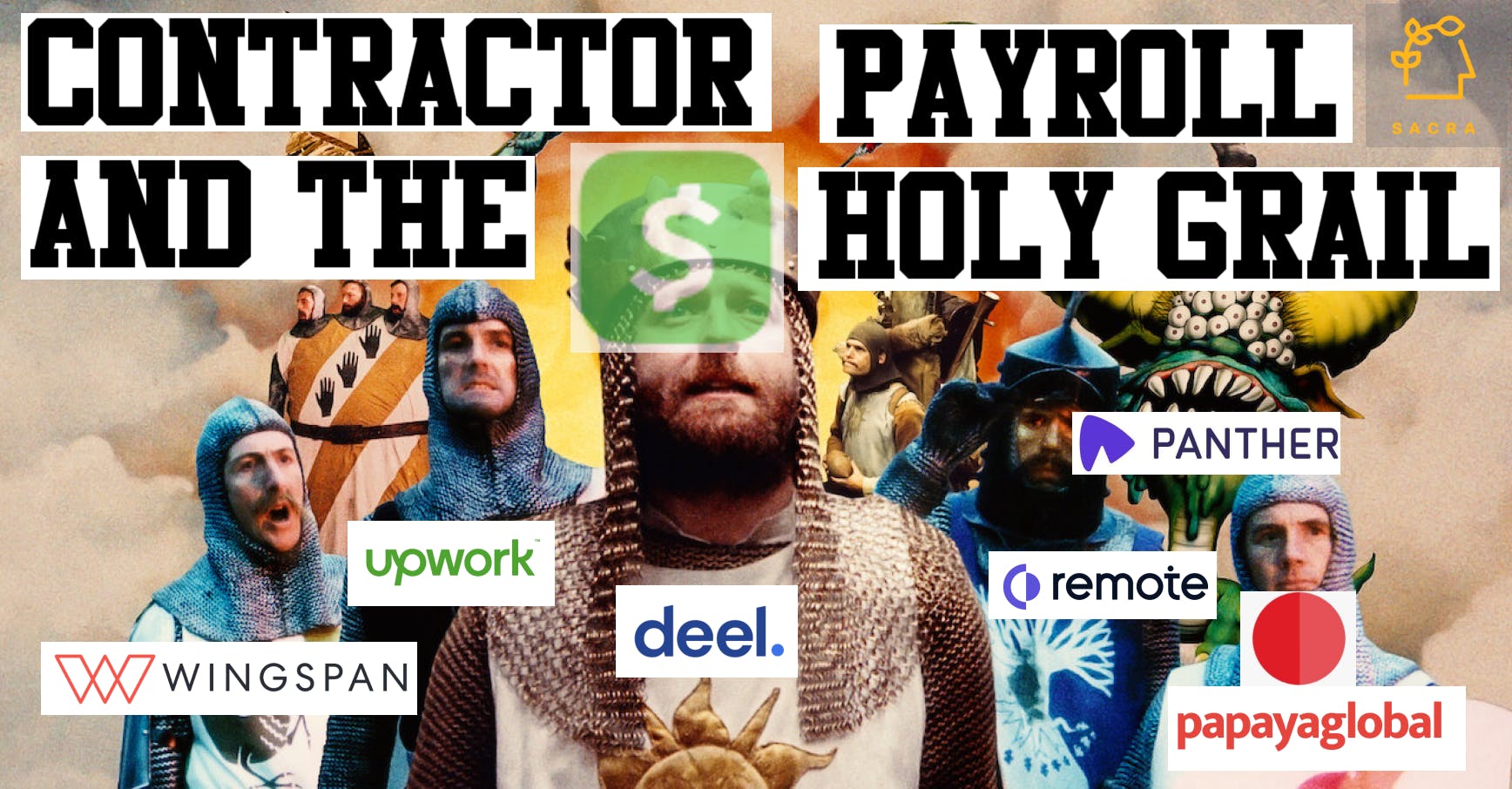Anthony Mironov, CEO of Wingspan, on building financial services for contractors
 Jan-Erik Asplund
Jan-Erik Asplund

Background
Anthony Mironov is the CEO of Wingspan. We talked to Anthony because Wingspan sits at the middle of two important trends: 1) new global payroll companies that allow companies to easily pay contractors anywhere, and 2) vertical SaaS platforms targeting HR and payroll as key wedge use cases from which to expand.
Questions
- Can you give a little background on the origin story of Wingspan and what services you provide?
- As far as reverse engineering a paycheck, are there tools and software that are popular that people traditionally use for that?
- Most payroll and benefits products are sold to the companies that are doing the hiring, and not positioned towards freelancers or contractors. Strategically, why was it important for Wingspan to offer the product to individuals?
- Are you seeing freelancers being able to exert any influence over what payroll software they want companies to use?
- What are the commonalities with companies who rely so heavily on contractors? Or is there a shift across the board to using that kind of labor?
- How do you think about how we got to this point as far as the talent marketplace and the need to retain talent?
- One interesting dimension is international versus domestic labor. Do you think about expanding or does Wingspan consider domestic an interesting place to play on its own?
- If a company had half their contractors domestic and a few overseas workers, where would Wingspan fit in for that kind of team, one that’s partially dispersed?
- Do you see more domestically focused companies like Gusto and Justworks as potential competitors here?
- What is it like for freelancers when they use Wingspan? Do they get a dashboard similar to Gusto or Justworks, where they can see when they’re going to get paid and so on?
- You mentioned some of the integrations being API first. For some of these mid-market companies with a thousand plus employees, how big of a focus is it to integrate with other things in the stack, like TriNet? Is that something you’re focused on?
- Do you have any product market fit numbers or data you could share?
- Gusto Wallet and Deel have something vaguely similar on the banking side. We looked at it in terms of the margins of payroll being low, but some companies layer on banking features to drive higher margin revenue. How do you think about that?
- How do you think about the opportunity to have a “Wingspan Wallet” so folks can keep their money with you?
- Is there evidence of network effect, that customers using Wingspan across the board want to stay on the platform? Have you seen folks put this in their hiring ads or advertise it in some way? Or contractors insisting on bringing it from job to job?
- What does your tech stack look like? Are you using a BaaS provider?
- What was the clinching factor about working with Unit? What was the selection process?
Interview
Can you give a little background on the origin story of Wingspan and what services you provide?
I spent the majority of my career working in payroll and benefits for small businesses.
I became a freelancer myself at the end of 2016, and quickly realized that I could earn a great living working on my own terms. But it was really, really difficult. I started Googling: “How do you send an invoice? What's a contract? How do you piece together these disparate insurance providers like Oscar and Guardian?”
When tax season came around, I had to basically lock myself in a room for a week to reconcile my entire life.
I did that for a few cycles, and it opened up my eyes to this real pain point within the massive population that’s untethering from traditional employment structures—a pain point that has historically been solved by the traditional W2 paycheck.
As a full-time employee, you get paid every two weeks. Your taxes are withheld. You have access to benefits and services provided by your company or the government in the US, and you're able to focus on the work. I've spoken to a couple thousand freelancers by now, and everyone kind of struggles with the same problem. They're reverse engineering a paycheck, trying to piece together infrastructure that nobody should be really building on their own.
Wingspan is a connected system between companies and freelancers that makes working with freelancers and contractors effortless. What does that mean?
For companies, we automate onboarding, payments, compliance, and reporting.
For individual freelancers, they get a beautiful operating system. Every time they get paid, they can automatically withhold for their taxes. We offer automated bookkeeping. We're also a licensed insurance agent, so we can provide them Fortune 500 company benefits. It makes both sides of this new working paradigm possible.
As far as reverse engineering a paycheck, are there tools and software that are popular that people traditionally use for that?
On the company side, our target customers are mid-market companies that are reliant on freelancers. They'll be paying a hundred, or a thousand, or many thousands of contractors at once.
They're usually using legacy payroll systems, like Paycom, Paychex, or ADP. Those systems were never really designed to programmatically pay a thousand contractors at once.
Some companies use AP automation solutions like Bill.com, which were never really designed to pay individuals at all.
The problem is that every time a company wants to work with a freelancer they need to get a W-9 at the beginning of the engagement and issue a 1099 at the end of the year. There's a massive list of things like e-signatures and background checks within that process, and every single person is treated as an individual vendor, which puts an enormous amount of administrative burden on a couple different teams. Usually the operations team, finance team and HR team bear the bulk of that, and it's really chaotic.
It's really blocking companies from working with freelancers more. Our opportunity is to create an experience that makes it really easy for companies to work with contractors.
On the individual side, they're really hacking together systems. In my own personal experience as a freelancer, Bank of America never sent me a notification that I got paid. I wasn’t automatically allocating additional funds to a tax withholding account, and most contractors I speak to don't have the discipline to do it manually. For taxes, most freelancers eventually end up hiring a really expensive CPA. So we let freelancers work through that flow across all of these products that we provide, and it all gets done with smart automations.
Most payroll and benefits products are sold to the companies that are doing the hiring, and not positioned towards freelancers or contractors. Strategically, why was it important for Wingspan to offer the product to individuals?
We started 100% D2C and iterated around the product experience because that was a gigantic gap in the marketplace.
Nobody had designed an all-in-one operating system that does payments, benefits, taxes, and everything that you need as a contractor. We saw that gap and built a really beautiful consumer experience with the thesis that the individual is gaining more power.
They demand a better experience than logging into a TriNet portal or an ADP portal, which don’t provide anything for contractors besides a payment amount.
Backtracking a few years, as we were thinking about how we could reimagine the payroll experience for this super fragmented marketplace, we realized we had to own the payment stream. Who starts the payment stream? It starts with companies: hence our go-to-market strategy of selling to companies and providing a beautiful experience for their end users.
Are you seeing freelancers being able to exert any influence over what payroll software they want companies to use?
The influence is actually coming from the companies.
We win in the marketplace because of our beautiful end user experience. The companies that are a good fit for Wingspan want to invest in their teams because they depend on contractors. These companies don’t have a thousand employees and then two contractors that they can just pay through Chase. And they realize that, especially in the talent marketplace right now, there's too many options for individuals—any way that they can invest in those folks will help them recruit and retain talent.
What are the commonalities with companies who rely so heavily on contractors? Or is there a shift across the board to using that kind of labor?
At our core target customer right now, structurally, there's usually a big payer, then a middle administrative company, and then hundreds or thousands of contractors. This is a traditional agency structure.
We work with a lot of companies in the insurance and creative spaces. We have a big on-demand nursing platform. These companies don't sound the same, but structurally, they are. Whether it’s a hospital system paying an administrative company that has many tens and tens of thousands of contractors or a big insurance carrier or a big brand like Pepsi or Google, they don't want to necessarily manage the administrative load from direct relationships with their contractors. Our target customers are effectively managing those projects.
How do you think about how we got to this point as far as the talent marketplace and the need to retain talent?
The trend is just growing as people’s ability to monetize skilled work is growing. This isn't physical labor. Our target customer is much higher-earning folks, and they’re usually transacting on ACH or checks.
This kind of knowledge-based work runs the country, and the need for it is only growing because it's more flexible and companies are always looking for specialized talent. When everyone is fighting over the best talent pool, that's when the shift to the individual end user comes.
One interesting dimension is international versus domestic labor. Do you think about expanding or does Wingspan consider domestic an interesting place to play on its own?
We have an international payments infrastructure we can use to pay people very quickly over local rails throughout the world.
Similar to our own domestic payments infrastructure, we like to partner with organizations that are super low in the stack. Our core business is focused on companies that are primarily US focused. They might have 10% or 20%—sometimes up to 50%—of their workforce internationally.
With the Deels and Remotes of the world, it's flipped. Their contracting pool is primarily overseas and they're setting up entities for that. Our use case is a little bit more simple.
If a company had half their contractors domestic and a few overseas workers, where would Wingspan fit in for that kind of team, one that’s partially dispersed?
If employees need an employer of record somewhere abroad, there are solutions. Deel is wonderful for that. Historically, it would cost a lot in legal fees to figure out how to hire folks in various countries. And it’s adding complexity with every country that’s added.
If your business is primarily US-domiciled and you're paying US contractors, we're a really wonderful fit.
The interesting related question is how US-based W-2s versus contractors play into it. We're in pretty deep conversations with partnerships to provide Wingspan as an augment to the W-2 services in the US.
Do you see more domestically focused companies like Gusto and Justworks as potential competitors here?
We see them as partners rather than competitors.
First of all, there's a segmentation issue: companies that are using Gusto or Justworks usually have two to twenty employees. We're working with mid-market companies that are much larger and their workforces are much larger.
What we see is that those companies need a layer of orchestration and automation before the actual payment stream comes out. We're actually API-first, and being an API-first platform, we're able to connect directly into project management systems and report out to ERP systems.
That adds a really significant competitive advantage for us. What typically happens today is a company with 500 contractors will export a spreadsheet, then they upload it into Bill.com, and then Bill.com will send the payment out eventually.
The problem is that it doesn't really remove any of the work because it's still very manual. That's why folks want to pay once or twice a month because it's so painful. But because we can integrate directly with their systems via API, we can pay as frequently as every day.
What is it like for freelancers when they use Wingspan? Do they get a dashboard similar to Gusto or Justworks, where they can see when they’re going to get paid and so on?
It goes both ways.
Some companies have their freelancers invoice through Wingspan. Other times it's fully transparent both ways, so a contractor knows exactly when they're going to get paid.
It's closer to a Gusto Wallet experience because everything is built on top of our own banking infrastructure specifically designed for 1099 workers.
For the companies that we work with, to get paid you have to use Wingspan. They go through a 90 second onboarding experience, they get paid and then they get access to all of these products if they choose to use them.
You mentioned some of the integrations being API first. For some of these mid-market companies with a thousand plus employees, how big of a focus is it to integrate with other things in the stack, like TriNet? Is that something you’re focused on?
It's usually not the payroll system. It's usually a project management system.
For insurance, it’s a claims management system. Sometimes it's as easy as an Airtable, which we have an integration to.
As soon as they know that they owe money, they can pay through Wingspan. We listen to all those signals.
Our goal is to automate as much of their workflow as possible, and integrations are a huge part of that. Not only do we integrate with their in-house systems, but our ecosystem of valuable integrations allow us to bring their workflow right into our application. For example, e-signatures. Part of that 90 second onboarding experience is embedded e-signatures for the contracts and background checks. Then companies can remove several of their vendors and streamline all the orchestrations through Wingspan.
The last piece that's really important is the integration of the outputs so we can reconcile all of the payment streams and close the books faster.
Do you have any product market fit numbers or data you could share?
We’re running a couple hundred million dollars of payments right now and doubling every month or two. We'll be north of a billion by the end of the year.
We're feeling really good about product market fit because both companies and individual end users really love the product. This was started as a product first company, and we're building out the commercial engine right now.
Gusto Wallet and Deel have something vaguely similar on the banking side. We looked at it in terms of the margins of payroll being low, but some companies layer on banking features to drive higher margin revenue. How do you think about that?
We think about it in terms of the overall lifetime value of the customer relationship and the end user.
On the company side, we have really simple pricing. We charge a flat platform fee plus a per paid contractor fee. Whether it's 5 contractors in that month or 1,500, there's a fixed fee and a variable fee.
On the end user side, it's free to use Wingspan, but there's ways for us to monetize that through Fintech usage. For instance, we earn interchange on card spend, interest on deposits, international payments and instant payouts. We’re also a licensed insurance agent across Health, Life and P&C, so we can earn recurring insurance commissions as the web broker.
How do you think about the opportunity to have a “Wingspan Wallet” so folks can keep their money with you?
We already do that. For instance, every time someone gets paid, they can elect to withhold taxes for their tax withholding or send money to their business accounts to spend via debit card. That's a wildly popular feature for us. Then we pay the IRS with one click and we give them automated bookkeeping to find their tax write-offs.
The system really works much better if folks are using all of the products or most of the products, but we understand that everybody has their own system. It's our opportunity to expand those relationships over time.
Is there evidence of network effect, that customers using Wingspan across the board want to stay on the platform? Have you seen folks put this in their hiring ads or advertise it in some way? Or contractors insisting on bringing it from job to job?
It's relatively early, but we're absolutely seeing that.
Three of our corporate customers recently sent out a joint press release about working with Wingspan, and how it’s providing a better experience for them because they see this as a really valuable recruiting and retention tool. We’re seeing companies add it to their job descriptions too.
Also, once you go through onboarding once, you don't have to go through onboarding again. We're seeing companies inviting folks to get paid and they’re already on the platform so the reduction of admin work starts compounding. For instance, their background checks might already be in place.
This motion becomes a flywheel for us, because we have the individual experience, we see a lot of individuals start invoicing out to their clients. We have a unique payment gateway that opens up the ecosystem a lot. Even Upwork or various platforms can start depositing money directly. We automatically create invoices for both sides for tracking purposes.
We are seeing expansion of these opportunities over time—both network effects and virality.
The network effect side is that folks don't need to provide their W-9s to all of their clients on Wingspan because it's all automatically created, so that gives them operating leverage.
The virality side is that once you're on Wingspan, it's really easy to get paid, and the invoice becomes a nice growth mechanism. And on average, our freelancers are invoicing—on a trailing kind of four or five week basis—four to five different clients. Usually they're working with anywhere between four to sixteen clients per year, throughout the year's lifecycle.
What does your tech stack look like? Are you using a BaaS provider?
We partner with the Unit team, and they’re amazing partners. Because everything is built on our banking infrastructure it allows us to move money a lot faster than traditional payroll companies—everybody effectively has their own banking account.
There's an enormous amount of income volatility for contractors. I remember when I was a contractor myself, I could provide my income streams, but I didn't have a paycheck. The whole world is designed around this bi-weekly paycheck. We can help facilitate that, and help companies in really competitive landscapes pay folks faster.
With the cards, we can do instant deposits and much faster payment streams, which is really important in this competitive landscape. The average invoice takes around 34 days for a big company to pay, because it gets lost in the mail, and somebody eats the check.
What was the clinching factor about working with Unit? What was the selection process?
We looked at every banking provider out there—or a lot of them—and Unit had a much more modern way of going about it. We launched in about four weeks and have really enjoyed building with them.
That's very fast and we like to move really, really fast. In the past twelve months we've released sixty or seventy features. There's a good culture fit between our teams and their teams.
Disclaimers
This transcript is for information purposes only and does not constitute advice of any type or trade recommendation and should not form the basis of any investment decision. Sacra accepts no liability for the transcript or for any errors, omissions or inaccuracies in respect of it. The views of the experts expressed in the transcript are those of the experts and they are not endorsed by, nor do they represent the opinion of Sacra. Sacra reserves all copyright, intellectual property rights in the transcript. Any modification, copying, displaying, distributing, transmitting, publishing, licensing, creating derivative works from, or selling any transcript is strictly prohibited.










